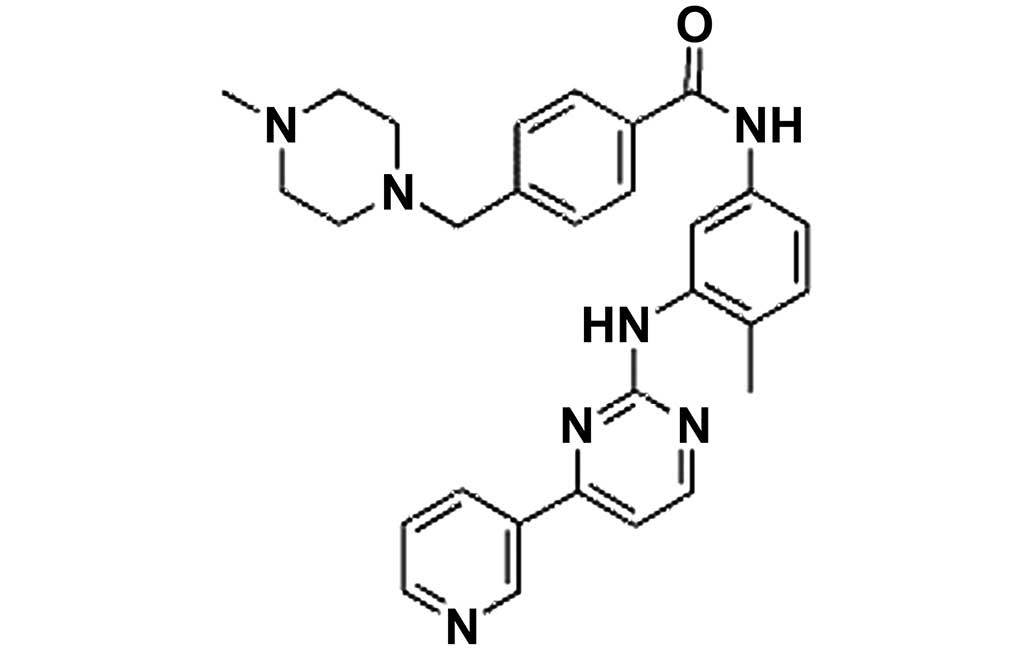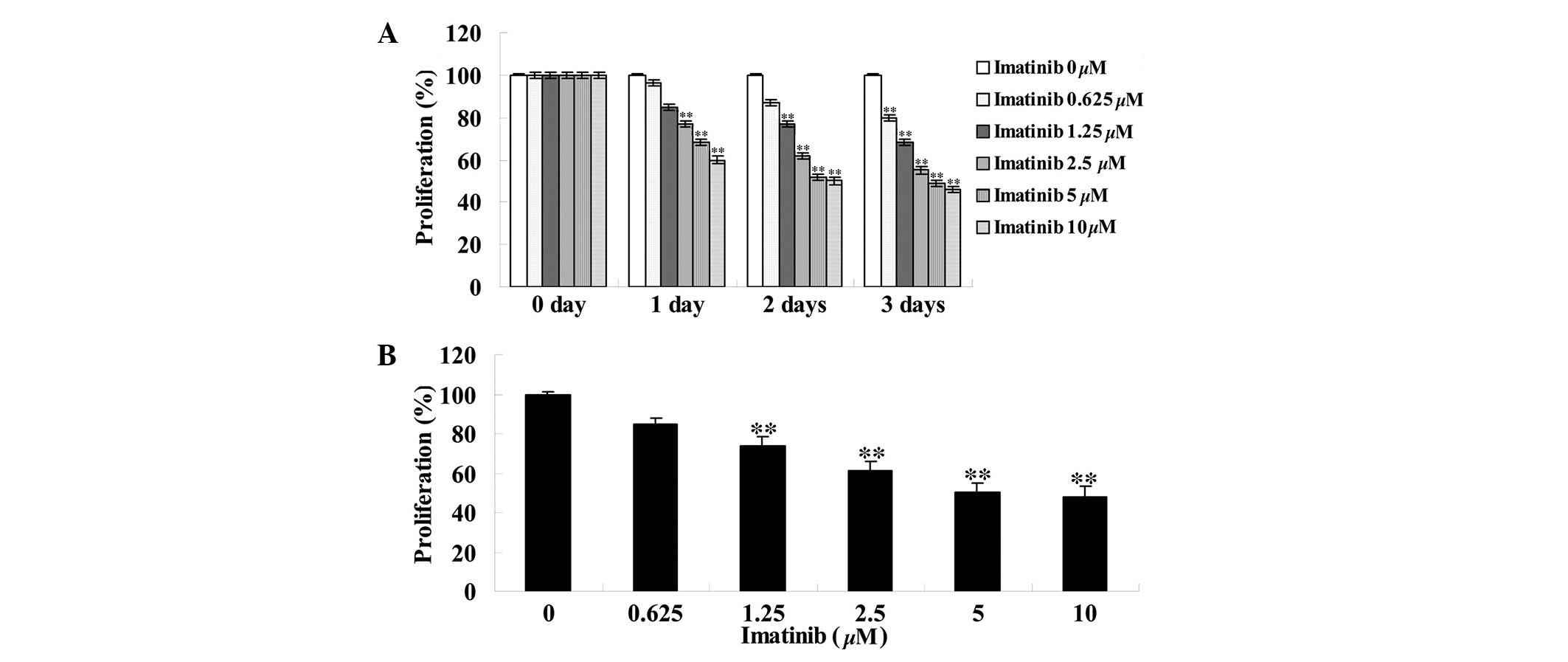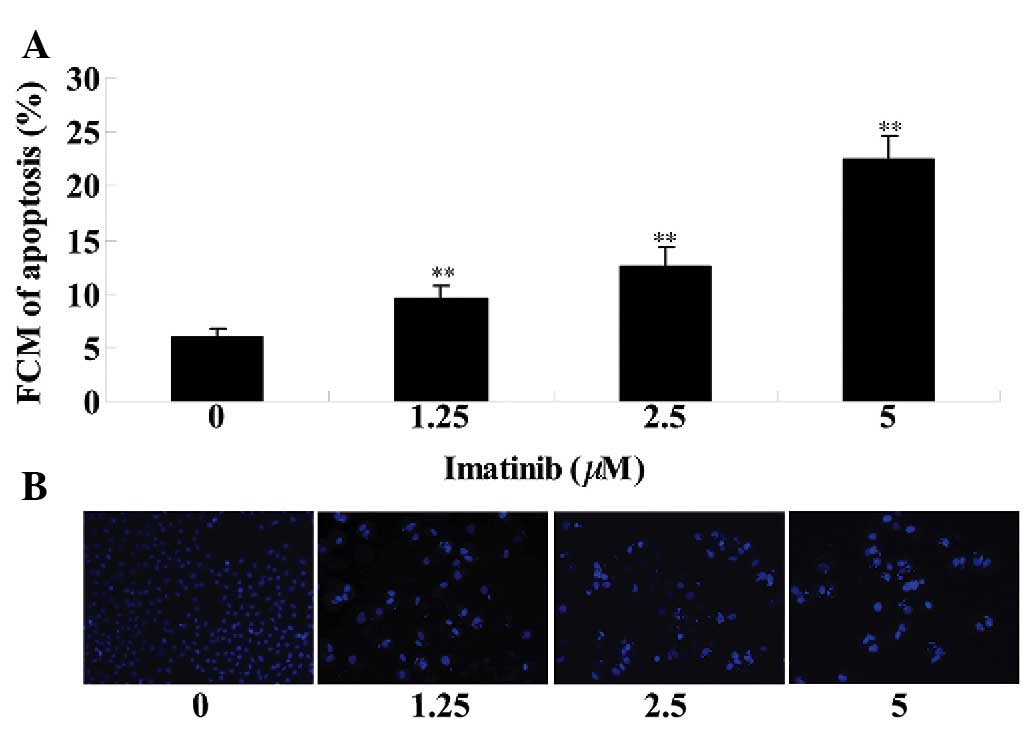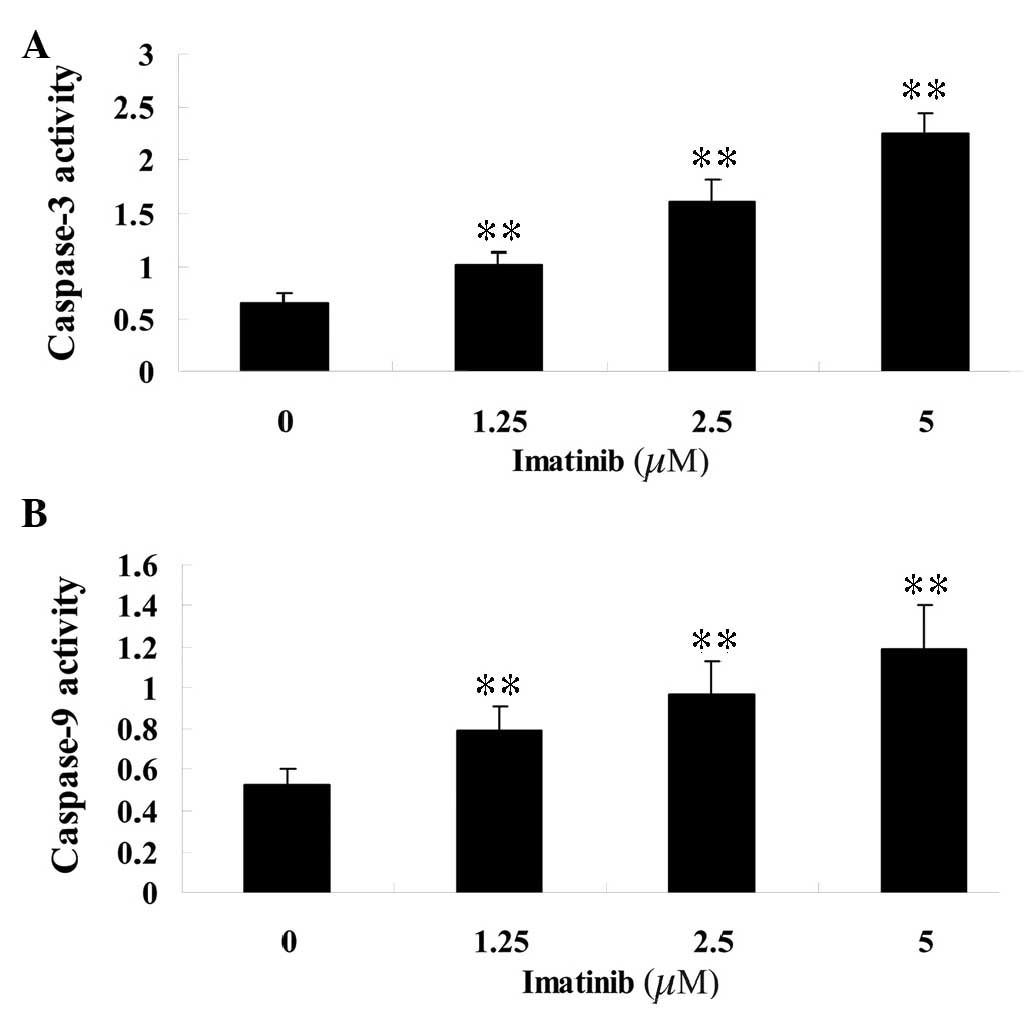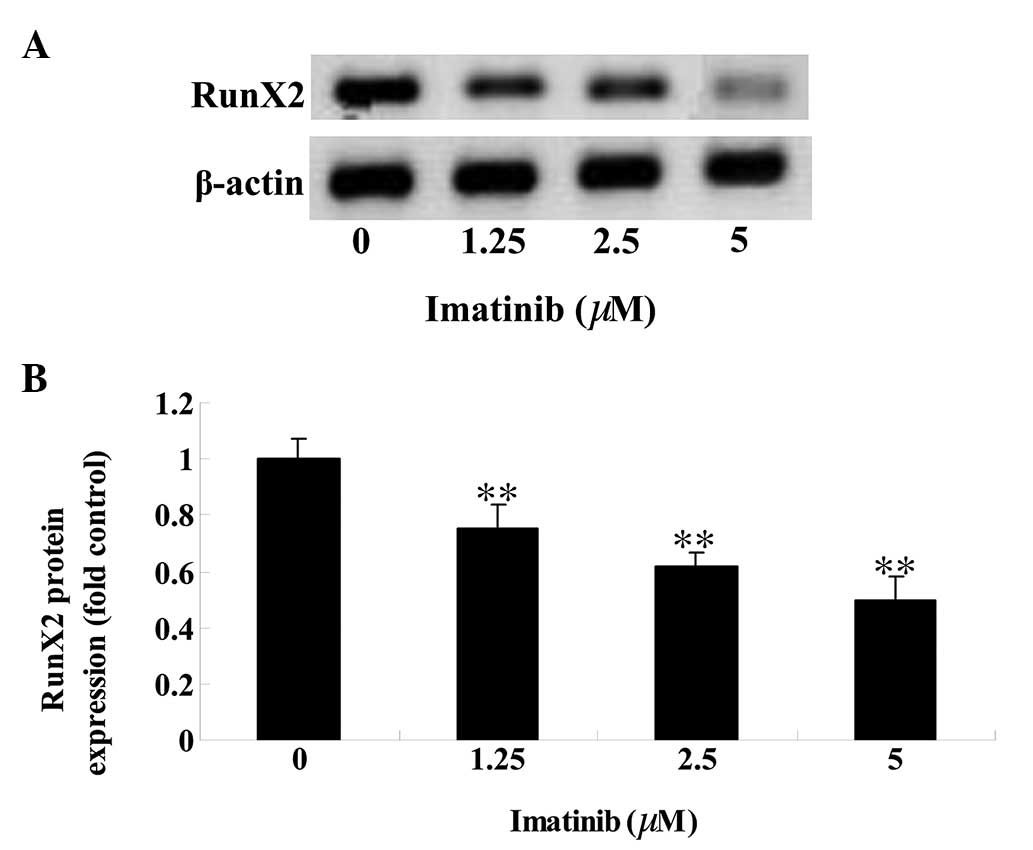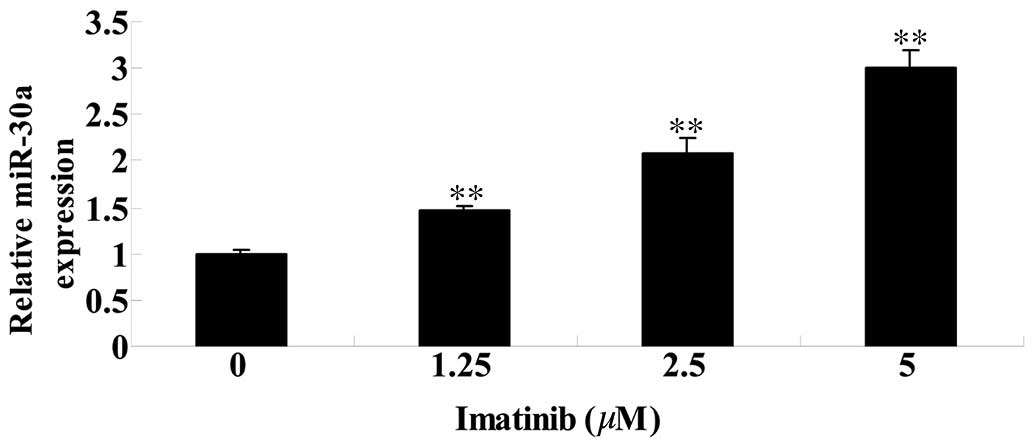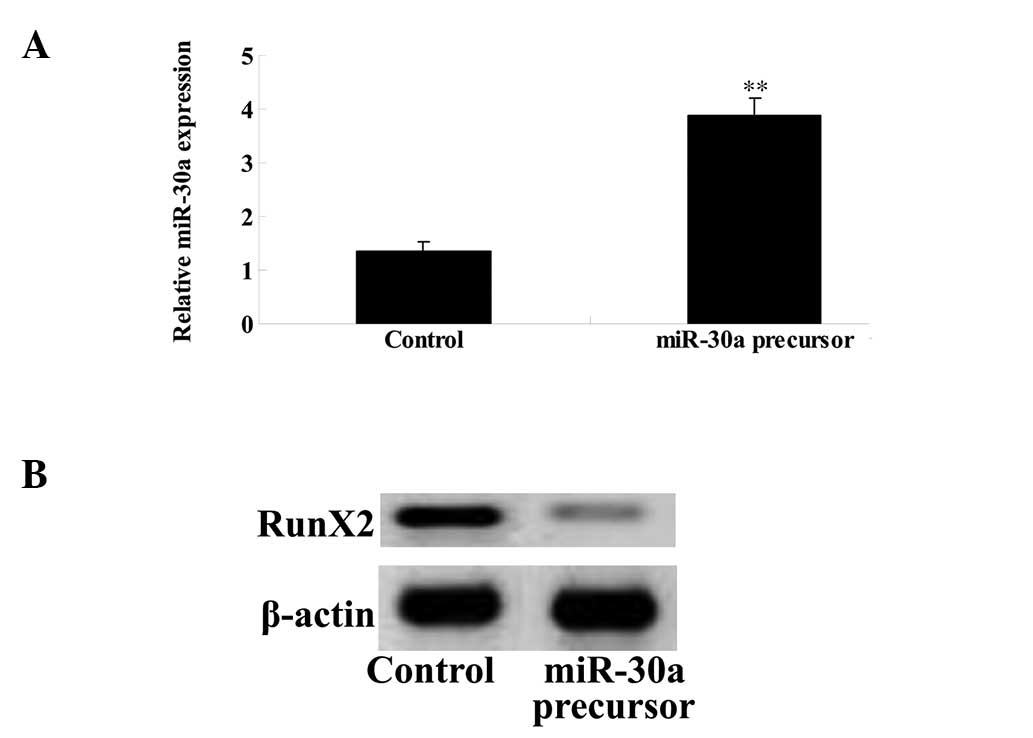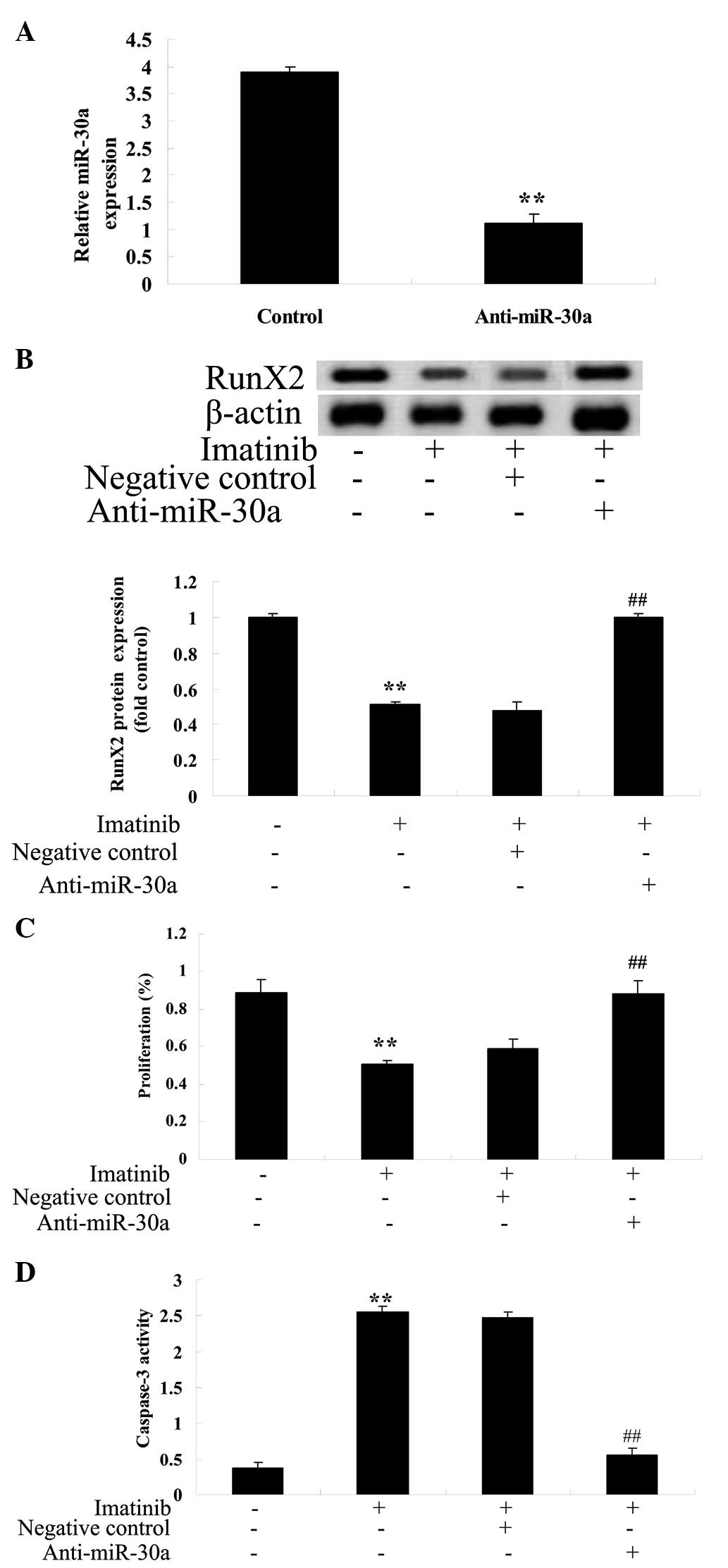Imatinib promotes apoptosis of giant cell tumor cells by targeting microRNA-30a-mediated runt‑related transcription factor 2
- Authors:
- Published online on: December 28, 2015 https://doi.org/10.3892/mmr.2015.4722
- Pages: 1739-1745
Abstract
Introduction
Giant cell tumor (GCT) is a disease, which is characterized by locally aggressive behavior, and designated as an osteoclastoma due to the multi-nucleated, osteoclast-like giant cells observed morphologically and histologically (1,2). GCT accounts for 11% of all bone tumors in China, with the second highest incidence after osteochondroma (3).
Runt-related transcription factor 2 (RunX2), also termed core-binding factor α1, belongs to the transcription factors of the Runt domain gene family. The expression of RunX2 is regulated by multiple growth factors and hormones involved in bone cell differentiation (3,4). Mak et al (5) reported that RunX2 is crucial in GCT stromal cells through upregulation of matrix metalloproteinase-13. Singh et al (6) confirmed the significant role of fibroblast growth factor receptor-2 signaling in osteoblastic differentiation in GCT stromal cells via inhibition of the extracellular signal-regulated kinases 1 and 2 (ERK1/2) signaling pathway.
MicroRNAs (miRs) are widely distributed in a variety of organisms and regulate gene expression. They are involved in the proliferation, differentiation and apoptosis of cells, in addition to other important cell regulatory activities (7). The miR-30a genes exist in the genome in a variety of forms. Previous studies have demonstrated that miRs may produce similar effects to oncogenes or tumor suppressor genes and various types of miR-30a are expressed abnormally in GCT tissues (8–10). Furthermore, Huang et al (11) suggested that miR-30a inhibited GCT of bone by targeting RunX2.
Imatinib is a selective inhibitor of certain type III tyrosine kinase receptor family members, including CD117, platelet-derived growth factor receptor and the ABL family of tyrosine kinases, which leads to inhibition of BCR-ABL protein expression (12). Studies have demonstrated that imatinib competes with ATP in binding to the nucleotide-binding site catalyzed by the tyrosine kinase (13–15). The catalytic activity of the kinase, therefore, cannot occur and the phosphorylated substrate cannot interact with downstream effector molecules, which leads to the inhibition of cell proliferation and induces apoptosis (16). In the present study, the anticancer effect of imatinib on GCT cell apoptosis was evaluated and the signaling cascades that may mediate this effect were investigated. The findings of the present study indicate that imatinib regulates apoptosis of GCT cells by suppression of RunX2 and activation of miR-30a, indicating that imatinib may serve as an important novel molecular target for the treatment of GCT.
Materials and methods
Reagents
The chemical structure of imatinib (Sigma-Aldrich, St. Louis, MO, USA; purity, ≥98%) is presented in Fig. 1. Hyclone RPMI-1640 was obtained from GE Healthcare Life Sciences (Logan, UT, USA) and Gibco fetal bovine serum (FBS) was obtained from Thermo Fisher Scientific, Inc. (Waltham, MA, USA). A Vybrant® MTT Cell Proliferation Assay kit was purchased from Molecular Probes (Thermo Fisher Scientific, Inc.), and Caspase-3 and -9 Colorimetric Assay kits were purchased from Beyotime Institute of Biotechnology (Jiangsu, China). A Molecular Probes Annexin V-FITC/PI Apoptosis Detection kit was obtained from Thermo Fisher Scientific, Inc. A BCA Protein Assay kit was obtained from Beyotime Institute of Biotechnology (Nanjing, China). TRIzol® and an miRNA qRT-PCR kit were obtained from Invitrogen (Thermo Fisher Scientific, Inc.).
Ethics statement, tissue samples and cell lines
The present study was approved by the regional ethics committee of Second Xiangya Hospital, Central South University (Changsha, China) and written informed consent was obtained from the patients. GCT samples were collected from male patients (age, 58 ±5 years) at the Second Xiangya Hospital, Central South University between October 2013 and January 2014. The tumor tissue samples were maintained in RPMI-1640 containing 10% FBS, 100 U/ml penicillin and 100 mg/ml streptomycin (both Amresco, LLC, Solon, OH, USA). The small sections of tissue (500 mg) and the resultant cell suspension were transferred to 25-cm2 flasks, which were incubated at 37°C in a humidified atmosphere of 5% CO2. Half of the culture medium was replaced with fresh complete medium every 2 days. Primary cultures were subcultured and stored in liquid nitrogen until reaching confluence. The purified GCT samples then underwent bisphosphonate treatment (Amresco, LLC) and evaluation (2). GCT cells (2.5×105 cells/well) were cultured in complete medium and treated with imatinib at different concentrations (0, 0.625, 1.25, 2.5, 5 and 10 µM) for 3 days.
Cell viability assay
GCT cells (2.0×104 cells/well) were seeded in 96-well plates and cultured with imatinib (0, 0.625, 1.25, 2.5, 5 and 10 µM) at a temperature of 37°C in a humidified atmosphere of 5% CO2 for 0, 1, 2 and 3 days. The cell viability was determined using the MTT assay. MTT (10 µl) was added to each well and incubated for 4 h at 37°C in a humidified atmosphere of 5% CO2. The culture medium was removed and 150 µl dimethyl sulfoxide (Invitrogen; Thermo Fisher Scientific, Inc.) was added to each well and incubated for 20 min at room temperature whilst being agitated. The absorbance was determined with an ELISA reader (Infinite® 200 PRO; Tecan, Männedorf, Switzerland) at a wavelength of 570 nm.
Flow cytometric analysis of GCT cell apoptosis
GCT cells (2.5×105 cells/well) were seeded in 6-well plates and cultured with imatinib (1.25, 2.5 and 5 µM) for 48 h. GCT cells were washed twice with ice-cold phosphate-buffered saline (Beyotime Institute of Biotechnology). The cells were stained with 10 µl Annexin V-fluorescein isothiocyanate and incubated for 10 min in the dark. Next, 10 µl propidium iodide was added to the cells and cell apoptosis was immediately detected using an EPICS® ALTRA™ flow cytometer (Beckman Coulter, Inc., Brea, CA, USA).
Detection of caspase-3 and -9 activity levels
GCT cells (2.5×105 cells/well) were seeded in 6-well plates and cultured with imatinib (1.25, 2.5 and 5 µM) for 48 h. The caspase-3 and -9 activity level was detected via fluorescence at a wavelength of 405 nm using the caspase-3 and -9 colorimetric assay kits.
Western blotting for RunX2 protein expression levels
GCT cells (2.5×105 cells/well) were seeded in 6-well plates and cultured with imatinib (1.25, 2.5 and 5 µM) for 48 h. The cells were incubated with ice-cold lysis buffer (Beyotime Institue of Biotechnology) and maintained for 30 min on ice. The suspension was centrifuged at 12,000 × g for 10 min at 4°C. The liquid supernatant was collected to measure the protein concentration using the BCA protein assay. Proteins were separated using 12% sodium dodecyl sulfate-polyacrylamide gels (Beyotime Institute of Biotechnology) with Coomassie Brilliant Blue (Sangon Biotech Co., Ltd., Shanghai, China) and transferred to polyvinylidene fluoride membranes (0.22 mm; EMD Millipore, Billerica, MA, USA). The blotting membrane was treated with Tris-buffered saline (TBS) containing 5% non-fat milk to block non-specific binding sites. The membranes were then incubated with mouse monoclonal RunX2 (1:1,000; cat. no. sc-390715; Santa Cruz Biotechnology, Inc., Dallas, TX, USA) and rabbit polyclonal anti-β-actin (1:500; cat. no. D110007; Sangon Biotech) antibodies overnight at 4°C. The membrane was washed twice with TBS with Tween-20 for 2 h and incubated with monoclonal anti-mouse immunoglobulin G (1:1,000; cat. no. sc-51997; Santa Cruz Biotechnology, Inc.) conjugated with horseradish peroxidase for 2 h. Enhanced chemiluminescence [GE Healthcare Life Sciences] was conducted to detect the protein expression level.
Quantitative polymerase chain reaction (qPCR) analysis of miR-30a expression levels
GCT cells (2.5×105 cells/well) were seeded in 6-well plates and cultured with imatinib (1.25, 2.5 and 5 µM) for 48 h. Total RNA was extracted from the cells using TRIzol® according to the manufacturer's instructions. The expression of miR-30a was detected using a Bulge-Loop® miRNA qRT-PCR kit (Sharp Bo Biological Technology Co., Ltd., Guangzou, China) and observed by qPCR. The primers used were as follows: Forward, 5′-GCAGTAAGTCACTTGCATGATTGT-3′ and revers, 5′-CGCTTGAAGCACTGTCTTATTTGT-3′ for miR-30a; and forward, 5′-GTTGACATCCGTAAAGACC-3′ and reverse, 5′-GGAGCCAGGGCAGTAA-3′ for U6.
Transfection of miR-30a and anti-miR-30a
The miR-30a precursor and anti-miR-30a (Ambion; Thermo Fisher Scientific, Inc.) were synthesized by Sangon Biotech Co., Ltd. and transfected using Invitrogen Lipofectamine 2000 (Thermo Fisher Scientific, Inc.) at a final concentration of 50 nM. GCT cells (2.5×105 cells/well) were seeded in 6-well plates for 6 h. The transfection media was then replaced with complete media without antibiotics in a humidified atmosphere at 37°C with 5% CO2 for 18 h.
Statistical analysis
Statistical analysis was performed with SPSS software version 17.0 (SPSS, Inc., Chicago, IL, USA). All experiments were performed at least three times and data are presented as means ± standard deviation. Data were analyzed using Student's t-test and P<0.05 was considered to indicate a statistically significant difference.
Results
Imatinib inhibited cell viability of GCT
To assess the effect of imatinib on cell viability, different concentrations (0, 0.625, 1.25, 2.5, 5 and 10 µM) of imatinib were incubated with GCT cells for 0, 1, 2 and 3 days subsequent to which an MTT assay was performed. As indicated in Fig. 2, imatinib inhibited the viability of GCT cells in a dose- and time-dependent manner. Compared with the control group, the viability of GCT cells significantly decreased in a dose-dependent manner following two days of treatment with 1.25, 2.5, 5 and 10 µM imatinib (P<0.01; Fig. 2B).
Imatinib induces cell apoptosis of GCT
Flow cytometry and DAPI staining were used to investigate the effects of imatinib on GCT apoptosis. As demonstrated in Fig. 3A, imatinib treatment (1.25, 2.5 or 5 µM) induced cell apoptosis of GCT at 2 days, when compared with the control group. As presented in Fig. 3B, the DAPI dye stained the morphologically normal nuclei blue. Morphologic analysis of apoptotic cells demonstrated shrunken and fragmented nuclei, as well as condensed chromatin while the nuclei of normal cells were round, sharp-edged and uniformly stained (Fig. 3B). GCT cell apoptosis was increased in the imatinib-treated (1.25, 2.5 or 5 µM) group at 2 days when compared with that of the control group (Fig. 3B).
Imatinib induces caspase-3 and -9 activity of GCT cells
To determine the effect of imatinib on the activity of caspase-3 and -9, varying concentrations (1.25, 2.5 and 5 µM) of imatinib were incubated with GCT cells for 2 days and assayed with colorimetric kits. Following treatment, the activity of caspase-3 and -9 in the GCT cells was significantly increased compared with that of the control group (Fig. 4).
Imatinib downregulates RunX2 protein expression in GCT
To determine the effect of imatinib on RunX2 protein expression levels in GCT cells, western blot analysis was performed. The RunX2 protein expression level in GCT cells was reduced in a dose-dependent manner following 2 days of treatment with 1.25, 2.5 and 5 µM imatinib (P<0.01; Fig. 5).
Imatinib activates miR-30a expression in GCT cells
To further investigate the effect of imatinib on miR-30a in GCT cels, the miR-30a expression level was analyzed using qPCR. Compared with the control group, the level of miR-30a expression was significantly increased following 2 days of imatinib treatment at concentrations of 1.25, 2.5 and 5 µM (P<0.01; Fig. 6).
Overexpression of miR-30a inhibits RunX2 expression of GCT cells
To investigate the mechanism underlying the effect of imatinib on GCT apoptosis, an miR-30a plasmid was transfected into the GCT cells. The miR-30a plasmid markedly upregulated the expression of miR-30a in the GCT cells (Fig. 7A), which reduced the level of RunX2 protein expression (Fig. 7B).
Anti-miR-30a reverses the effect of imatinib on GCT cells
To further investigate the potential association between miR-30a expression and the effect of imatinib on GCT cells, analysis of the effect of imatinib on GCT was conducted following transfection of an anti-miR-30a plasmid into GCT cells. The anti-miR-30a plasmid reduced the expression of miR-30a (Fig. 8A) and increased RunX2 protein expression (Fig. 8B). Furthermore, the anti-miR-30a plasmid increased cell viability (Fig. 8C) and reduced caspase-3 activity in GCT cells (Fig. 8D).
Discussion
GCT is a locally aggressive bone tumor, with characteristic postoperative recurrence of ≤42% (17). GCT contains fibroblast-like, spindle-shaped stromal cells, and multinucleated giant cells, which exhibit resorption activity that is similar to osteoclasts (18). The current study presented evidence that imatinib inhibited cell viability and promoted cell apoptosis in GCT in a dose-dependent manner. Maass et al (19) reported that imatinib cured patients with metastatic breast cancer, de Melo Campos et al (20) suggested that imatinib induced apoptosis of neoplastic mast cells and Halperin et al (21) reported that imatinib inhibited the viability of advanced endocrine cancer. In the present study, exposure to imatinib significantly increased the activity of caspase-3 and -9 in GCT cells. Zhang et al (22) suggested that imatinib increased the levels of cleaved caspase-3 and -9 in vitro and in vivo, and Gamas et al (23) demonstrated that imatinib mediated apoptosis of myelogenous leukemia cells by mediating caspase-3 activation.
ERK is an important signaling pathway for integrin signaling to the nucleus (24). Signaling molecules activate integrin, which promotes RunX2-dependent transcription and, using U0126, rapidly inhibits ERK phosphorylation and activation of the osteocalcin gene, upon which ERK is dependent. In a previous study, ERK1-overexpressing transfected cells were produced in which ERK1 elevated the level of osteocalcin mRNA and significantly increased the phosphorylation of RunX2, indicating that the phosphorylation cascade of mitogen-activated protein kinase (MAPK) may regulate the activity of RunX2 (25). Following integration of the integrin ligand with the integrin on the surface of osteoblasts, MAPK signaling pathways are activated to transfer signals to the nucleus, promoting the expression of RunX2 and RunX2 protein phosphorylation (26,27). Activated RunX2 promotes the differentiation of osteoblasts by activating marker genes of osteoblast cells (including osteocalcin) (28). In the present study, the RunX2 protein level in GCT cells was significantly decreased in a dose-dependent manner following two days of imatinib treatment. Jönsson et al (29) reported that imatinib inhibited the proliferation of human mesenchymal stem cells via modulation of RunX2 expression levels and Tibullo et al (30) demonstrated that imatinib potentially favored osteoblastogenesis by mRNA expression of RunX2.
miRs are closely associated with various types of cancer. Previous studies have demonstrated that breast (31), ovarian (32), gastric (33) and lung (34) cancer all demonstrate abnormal expression of miRs (35). miRNA-30a is closely associated with the occurrence and development of GCT, as well as other types of tumor (such as breast and renal cell cancers) (36,37). The study of miRs is important for early clinical diagnosis, treatment and prognosis of GCT. Specific miR-30a expression profiling of GCT, and detection and monitoring of miR-30a in the peripheral blood may serve as an effective marker for GCT diagnosis, screening and to produce effective, novel treatments (38). Data obtained in the present study suggest that imatinib treatment significantly increased the miR-30a expression in GCT cells. Yu et al (39) demonstrated that the administration of imatinib against human chronic myeloid leukemia cells functioned by targeting miR-30a-mediated processes. Furthermore, Yu et al (40) reported that imatinib promoted autophagy in response to cancer therapy via miR-30a-mediated processes. In the present study, overexpression of miR-30a was identified to inhibit RunX2 protein expression in GCT cells. Thus, downregulation of miR-30a may reverse the anticancer effect of imatinib and increase the level of RunX2 protein expression in GCT cells. Recent studies reported that miR-30a inhibited osteolysis by targeting miR-30a-mediated processes in GCTs of the bone (11,41).
In conclusion, the present study demonstrated that the anticancer effect of imatinib increases apoptosis of GCT cells by downregulating RunX2 protein expression and upregulating the expression of miR-30a. These data indicate that there may be potential benefits of administering imatinib in clinical practice in the future.
References
|
Wang T, Hou Y, Ding X, Song B, Wang F and Hou W: Overexpression, purification, molecular characterization and pharmacological evaluation for anticancer activity of ribosomal protein S23 from the giant panda (Ailuropoda melanoleuca). Mol Med Rep. 7:1875–1882. 2013.PubMed/NCBI | |
|
Yang T, Zheng XF, Li M, Lin X and Yin QS: Stimulation of osteogenic differentiation in stromal cells of giant cell tumour of bone by zoledronic acid. Asian Pac J Cancer Prev. 14:5379–5383. 2013. View Article : Google Scholar : PubMed/NCBI | |
|
Jiang N, Qin CH, Tan CX, Wen SF, Ma YF, Dong F, Diao XC, Zhang P and Yu B: A retrospective analysis of 140 patients with giant cell tumor in the extremity: a multicenter study based on four hospitals in South China. Cancer Epidemiol. 37:294–299. 2013. View Article : Google Scholar : PubMed/NCBI | |
|
Komori T: Mechanism of transcriptional regulation by Runx2 in osteoblasts. Clin Calcium. 16:801–807. 2006.In Japanese. PubMed/NCBI | |
|
Phimphilai M, Zhao Z, Boules H, Roca H and Franceschi RT: BMP signaling is required for RUNX2-dependent induction of the osteoblast phenotype. J Bone Miner Res. 21:637–646. 2006. View Article : Google Scholar : PubMed/NCBI | |
|
Mak IW, Cowan RW, Popovic S, Colterjohn N, Singh G and Ghert M: Upregulation of MMP-13 via Runx2 in the stromal cell of Giant Cell Tumor of bone. Bone. 45:377–386. 2009. View Article : Google Scholar : PubMed/NCBI | |
|
Singh S, Singh M, Mak IW, Turcotte R and Ghert M: Investigation of FGFR2-IIIC signaling via FGF-2 ligand for advancing GCT stromal cell differentiation. PLoS One. 7:e467692012. View Article : Google Scholar : PubMed/NCBI | |
|
Kumarswamy R, Mudduluru G, Ceppi P, Muppala S, Kozlowski M, Niklinski J, Papotti M and Allgayer H: MicroRNA-30a inhibits epithelial-to-mesenchymal transition by targeting Snai1 and is downregulated in non-small cell lung cancer. Int J Cancer. 130:2044–2053. 2012. View Article : Google Scholar | |
|
Liu J, Shi W, Wu C, Ju J and Jiang J: miR-181b as a key regulator of the oncogenic process and its clinical implications in cancer (Review). Biomed Rep. 2:7–11. 2014.PubMed/NCBI | |
|
Zou Z, Wu L, Ding H, Wang Y, Zhang Y, Chen X, Chen X, Zhang CY, Zhang Q and Zen K: MicroRNA-30a sensitizes tumor cells to cis-platinum via suppressing beclin 1-mediated autophagy. J Biol Chem. 287:4148–4156. 2012. View Article : Google Scholar : | |
|
Huang Q, Jiang Z, Meng T, Yin H, Wang J, Wan W, Cheng M, Yan W, Liu T, Song D, et al: MiR-30a inhibits osteolysis by targeting RunX2 in giant cell tumor of bone. Biochem Biophys Res Commun. 453:160–165. 2014. View Article : Google Scholar : PubMed/NCBI | |
|
Roth DB, Akbari S and Rothstein A: Macular ischemia associated with imatinib mesylate therapy for chronic myeloid leukemia. Retin Cases Brief Rep. 3:161–164. 2009. View Article : Google Scholar : PubMed/NCBI | |
|
Weisberg E, Deng X, Choi HG, Barrett R, Adamia S, Ray A, Moreno D, Kung AL, Gray N and Griffin JD: Beneficial effects of combining a type II ATP competitive inhibitor with an allosteric competitive inhibitor of BCR-ABL for the treatment of imatinib-sensitive and imatinib-resistant CML. Leukemia. 24:1375–1378. 2010. View Article : Google Scholar : PubMed/NCBI | |
|
Dohse M, Scharenberg C, Shukla S, et al: Comparison of ATP-binding cassette transporter interactions with the tyrosine kinase inhibitors imatinib, nilotinib, and dasatinib. Drug Metab Dispos. 38:1371–1380. 2010. View Article : Google Scholar : PubMed/NCBI | |
|
Sarszegi Z1, Bognar E, Gaszner B, Kónyi A, Gallyas F Jr, Sumegi B and Berente Z: BGP-15, a PARP-inhibitor, prevents imatinib-induced cardiotoxicity by activating Akt and suppressing JNK and p38 MAP kinases. Mol Cell Biochem. 365:129–137. 2012. View Article : Google Scholar : PubMed/NCBI | |
|
Grunwald L, Mehta S, Hogarty MD and Liu GT: Chronic myelogenous leukemia and retinopathy treated with imatinib. Retin Cases Brief Rep. 5:366–368. 2011. View Article : Google Scholar : PubMed/NCBI | |
|
Park YS, Lee JK, Baek SW and Park CK: The rare case of giant cell tumor occuring in the axial skeleton after 15 years of follow-up: Case report. Oncol Lett. 2:1323–1326. 2011. | |
|
Fu S, Bai R, Zhao Z, Zhang Z, Zhang G, Wang Y, Wang Y, Jiang D and Zhu D: Overexpression of hypoxia-inducible factor-1α and vascular endothelial growth factor in sacral giant cell tumors and the correlation with tumor microvessel density. Exp Ther Med. 8:1453–1458. 2014.PubMed/NCBI | |
|
Maass N, Schem C, Bauerschlag DO, Tiemann K, Schaefer FW, Hanson S, Muth M, Baier M, Weigel MT, Wenners AS, et al: Final safety and efficacy analysis of a phase I/II trial with imatinib and vinorelbine for patients with metastatic breast cancer. Oncology. 87:300–310. 2014. View Article : Google Scholar : PubMed/NCBI | |
|
de Melo Campos P, Machado-Neto JA, Scopim-Ribeiro R, Visconte V, Tabarroki A, Duarte AS, Barra FF, Vassalo J, Rogers HJ, Lorand-Metze I, et al: Familial systemic mastocytosis with germline KIT K509I mutation is sensitive to treatment with imatinib, dasatinib and PKC412. Leuk Res. 38:1245–1251. 2014. View Article : Google Scholar : PubMed/NCBI | |
|
Halperin DM, Phan AT, Hoff AO, Aaron M, Yao JC and Hoff PM: A phase I study of imatinib, dacarbazine, and capecitabine in advanced endocrine cancers. BMC Cancer. 14:5612014. View Article : Google Scholar : PubMed/NCBI | |
|
Zhang YF, Xu GB, Gan YC, Xu XH and Xu RZ: Inhibitory effect of 4-chlorobenzoyl berbamine on imatinib-resistant K562 cells in vitro and in vivo. Nan Fang Yi Ke Da Xue Xue Bao. 31:1997–2001. 2011.In Chinese. PubMed/NCBI | |
|
Gamas P, Marchetti S, Puissant A, Grosso S, Jacquel A, Colosetti P, Pasquet JM, Mahon FX, Cassuto JP and Auberger P: Inhibition of imatinib-mediated apoptosis by the caspase-cleaved form of the tyrosine kinase Lyn in chronic myelogenous leukemia cells. Leukemia. 23:1500–1506. 2009. View Article : Google Scholar : PubMed/NCBI | |
|
Tatematsu T, Sasaki H, Shimizu S, Okuda K, Shitara M, Hikosaka Y, Moriyama S, Yano M, Brown J and Fujii Y: Investigation of neurotrophic tyrosine kinase receptor 1 fusions and neurotrophic tyrosine kinase receptor family expression in non-small-cell lung cancer and sensitivity to AZD7451. Mol Clin Oncol. 2:725–730. 2014.PubMed/NCBI | |
|
Xiao ZS, Hjelmeland AB and Quarles LD: Selective deficiency of the bone-related Runx2-II unexpectedly preserves osteoblast-mediated skeletogenesis. J Biol Chem. 279:20307–20313. 2004. View Article : Google Scholar : PubMed/NCBI | |
|
Hu N, Feng C, Jiang Y, Miao Q and Liu H: Regulative effect of mir-205 on osteogenic differentiation of bone mesenchymal stem cells (BMSCs): Possible role of SATB2/Runx2 and ERK/MAPK pathway. Int J Mol Sci. 16:10491–10506. 2015. View Article : Google Scholar : PubMed/NCBI | |
|
Huang RL, Yuan Y, Tu J, Zou GM and Li Q: Opposing TNF-α/IL-1β- and BMP-2-activated MAPK signaling pathways converge on Runx2 to regulate BMP-2-induced osteoblastic differentiation. Cell Death Dis. 5:e11872014. View Article : Google Scholar | |
|
Glynn ER, Londono AS, Zinn SA, Hoagland TA and Govoni KE: Culture conditions for equine bone marrow mesenchymal stem cells and expression of key transcription factors during their differentiation into osteoblasts. J Anim Sci Biotechnol. 4:402013. View Article : Google Scholar : PubMed/NCBI | |
|
Jönsson S, Hjorth-Hansen H, Olsson B, Wadenvik H, Sundan A and Standal T: Imatinib inhibits proliferation of human mesenchymal stem cells and promotes early but not late osteoblast differentiation in vitro. J Bone Miner Metab. 30:119–123. 2012. View Article : Google Scholar | |
|
Tibullo D, Giallongo C, La Cava P, Beretta S, Stagno F, Chiarenza A, Conticello C, Palumbo GA and Di Raimondo F: Effects of imatinib mesylate in osteoblastogenesis. Exp Hematol. 37:461–468. 2009. View Article : Google Scholar : PubMed/NCBI | |
|
Heneghan HM, Miller N, Lowery AJ, Sweeney KJ, Newell J and Kerin MJ: Circulating microRNAs as novel minimally invasive biomarkers for breast cancer. Ann Surg. 251:499–505. 2010. View Article : Google Scholar : PubMed/NCBI | |
|
Corney DC, Hwang CI, Matoso A, Vogt M, Flesken-Nikitin A, Godwin AK, Kamat AA, Sood AK, Ellenson LH, Hermeking H and Nikitin AY: Frequent downregulation of miR-34 family in human ovarian cancers. Clin Cancer Res. 16:1119–1128. 2010. View Article : Google Scholar : PubMed/NCBI | |
|
Tsukamoto Y, Nakada C, Noguchi T, Tanigawa M, Nguyen LT, Uchida T, Hijiya N, Matsuura K, Fujioka T, Seto M and Moriyama M: MicroRNA-375 is downregulated in gastric carcinomas and regulates cell survival by targeting PDK1 and 14-3-3zeta. Cancer Res. 70:2339–2349. 2010. View Article : Google Scholar : PubMed/NCBI | |
|
Chacon-Cabrera A, Fermoselle C, Salmela I, Yelamos J and Barreiro E: MicroRNA expression and protein acetylation pattern in respiratory and limb muscles of Parp-1−/− and Parp-2−/− mice with lung cancer cachexia. Biochim Biophys Acta. 1850:2530–2543. 2015. View Article : Google Scholar : PubMed/NCBI | |
|
Kodahl AR, Lyng MB, Binder H, Cold S, Gravgaard K, Knoop AS and Ditzel HJ: Novel circulating microRNA signature as a potential non-invasive multi-marker test in ER-positive early-stage breast cancer: A case control study. Mol Oncol. 8:874–883. 2014. View Article : Google Scholar : PubMed/NCBI | |
|
Zeng RC, Zhang W, Yan XQ, Ye ZQ, Chen ED, Huang DP, Zhang XH and Huang GL: Down-regulation of miRNA-30a in human plasma is a novel marker for breast cancer. Med Oncol. 30:4772013. View Article : Google Scholar : PubMed/NCBI | |
|
Zheng B, Zhu H, Gu D, Pan X2 Qian L, Xue B, Yang D, Zhou J and Shan Y: MiRNA-30a-mediated autophagy inhibition sensitizes renal cell carcinoma cells to sorafenib. Biochem Biophys Res Commun. 459:234–239. 2015. View Article : Google Scholar : PubMed/NCBI | |
|
Mao C, Zhang J, Lin S, Jing L, Xiang J, Wang M, Wang B, Xu P, Liu W, Song X and Changjun L: MiRNA-30a inhibits AECs-II apoptosis by blocking mitochondrial fission dependent on Drp-1. J Cell Mol Med. 18:2404–2416. 2014. View Article : Google Scholar : PubMed/NCBI | |
|
Yu Y, Yang L, Zhao M, Zhu S, Kang R, Vernon P, Tang D and Cao L: Targeting microRNA-30a-mediated autophagy enhances imatinib activity against human chronic myeloid leukemia cells. Leukemia. 26:1752–1760. 2012. View Article : Google Scholar : PubMed/NCBI | |
|
Yu Y, Cao L, Yang L, Kang R, Lotze M and Tang D: microRNA 30A promotes autophagy in response to cancer therapy. Autophagy. 8:853–855. 2012. View Article : Google Scholar : PubMed/NCBI | |
|
Eguchi T, Watanabe K, Hara ES, Ono M, Kuboki T and Calderwood SK: OstemiR: A novel panel of microRNA biomarkers in osteoblastic and osteocytic differentiation from mesencymal stem cells. PLoS One. 8:e587962013. View Article : Google Scholar : PubMed/NCBI |



